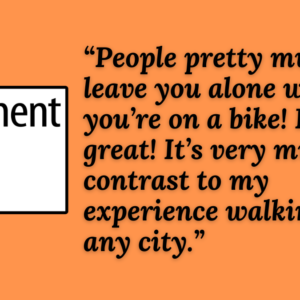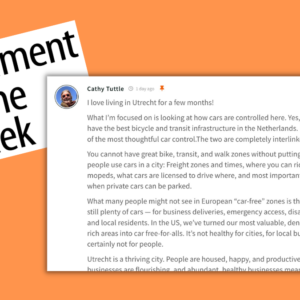This comment came in early last week, in response to the first of two BikePortland posts about a man killed by a driver on Southeast Belmont and Martin Luther King Jr. Blvd. The posts caused a whiplash of reaction as the details of the story emerged over several days. What had begun as another dangerous infrastructure story morphed into an intentional-act-of-violence story. Between them, they managed to touch upon all of our frustrations and hot-button issues. The constant was that people living on the streets are vulnerable.
This thoughtful comment by SD remained relevant even as the story changed. SD stepped back from the immediate incident to notice the cityscape that car infrastructure creates, specifically “dead zones,” and why those locations might appeal to someone living outside. It got me thinking about how a city takes its form, and how it forms the people who live in it.
Here’s what SD had to say:
An important point that may be missed here is that the interviews with the residents of this camp show that they are aware of how dangerous it is because of speeding cars, yet they choose to be here. Relative to other dangers or difficulties they face, the risk of cars, noise and exhaust are acceptable. I hope that people who read this story take a moment to consider how hard it is to be homeless. Homeless people are in many cases trying their best to be out of the way of society, but at the same time need to be close enough to meet basic needs and have the safety of being in a place where someone might hear you if you scream for help.
The other point is that car infrastructure creates dead zones in cities that most people avoid because it is harsh and repulsive. These dead zones are tolerable to homeless people because they meet other needs. If you laid out a map of Portland and gave someone that task of finding outdoor places for homeless people to sleep and camp that balanced the needs of the homeless with the desires of the housed population, I imagine that most people would choose these car infrastructure dead spaces as prime spots. I know that some people think we can sweep and starve the homeless problem out of existence, but the continued reemergence of these camps argues that this type of passive aggression is not a solution.
I keep thinking about Williams talking on OPB about pedestrian deaths in Portland and how she essentially said in a coded way that pedestrian deaths in Portland were due to homeless people and rhetorically minimized and shrugged off the problem.
Thank you SD for sharing your insights. You can read SD’s comment, and some other good ones too, under the original post.







Thanks for reading.
BikePortland has served this community with independent community journalism since 2005. We rely on subscriptions from readers like you to survive. Your financial support is vital in keeping this valuable resource alive and well.
Please subscribe today to strengthen and expand our work.
This comment reminds me of the scene from the cult classic Mexican film, “Y Tu mamá también”, where a street vendor is killed in his treacherous daily commute crossimg a high-speed arterial road in Mexico City. The tone in the film is ironic in the same way as this comment. For the main characters, two rich kids driving by in a fancy car their dad bought them, it’s just another day witnessing random carnage from a distance, behind a glass windshield. But for the street vendor, it’s his last day, and for his already struggling family, the beginning of a much harder life without their primary bread winner.
Ironic? Huh? Find me a single ironic phrase.
I thought the tone was compassionate. And I know SD gets around town on a bicycle.
The “dead zones” double entendre seems ironic to me.
I didn’t read it as a double entendre, I think you have to strain yourself to interpret it that way.
Seems to me that you’re suggesting the comment comes from a perspective similar to that of the rich kids in the film. If so, given how SD describes the dead zones and what people living there consider before choosing to stay there, I don’t think you could be more wrong.
I think you all are being way too hard on guy. He seems to agree with the spirit of SD’s comment.
I agree Guy’s comment appears mostly in line with SD’s, so if it wasn’t clear, I only meant mine as commentary on the idea that anything in SD’s comment was ironic.
This seems connected to ideas elsewhere… when we talk about differential environmental impacts… sometimes the highway goes through the poorer or racialized community, sometimes that community sets up there because that’s where people can afford to set up. Or when we talk about gentrification, where some people seem to embrace the unpleasant or even unhealthy or dangerous aspects of their neighborhood that seem to keep rent down, protecting them from displacement. Those choices aren’t as stark as pitching a tent next to roaring traffic but they’re in a similar direction.
If the crisis of rising pedestrian killings is concentrated among poorer people, especially homeless people… we have to be able to acknowledge that and acknowledge that this is meaningful. It makes a difference in what kinds of interventions can make a positive difference and what kinds might just push the people suffering most on to another, more dangerous corner.
I thought SD did an amazing and heartfelt job humanizing the people who live in those various “dead zones” throughout town in his several excellent posts. Normally I’m not a fan of long posts, but SD kept it real, to the point and somehow kept it all about the situation the people living in those zones endure for whatever reason.
This sentence for me really sums up the issues. He’s calling it a dead zone not to be ironic or clever, but because that is what they are.
The point for me is that NO ONE should be living under bridges or overpasses. Rather than rhapsodizing about “dead zones” and their meaning, we should be making sure that our city gov’t allows NO ONE to live in these unlivable spaces.
End of story.
“End of story”? I guess so, except for the people who have literally nowhere else to go. Once again it’s “out of sight, out of mind”.
Not all. If we want people not to live under bridges and overpasses, they need to have somewhere else to sleep, in both the short term and the long term. The county has a bunch of money specifically for this purpose, which they’ve decided to sit on rather than spend solving the problem.
But they do have somewhere to go. Place all your objects in a fairly large backpack and live in a shelter. Keep well groomed, lock your backpack in a locker as you go to work, utilize the shelter as an address, work with social workers for transitional housing, work with Central City Concern on employment. Save money, get a roommate and live in a small apartment. Take the bus or bike everywhere and frequent soup kitchens and food banks. Can for extra money, get on food stamps.
You can do it, but if you have mental health stuff going on, addictions or trauma, I understand why it wouldn’t be so easy.
But I think someone with a clear mind and free of trauma can pull it back together in under a year if they want it and put their nose to the grind stone.
That’s the thing, the severely chronic homeless are the ones that need tremendous amounts of intervention and help. However, there is a pretty good roadmap to getting out of homelessness in this city, when you can’t, it’s something extraordinary holding you back.